The NVIDIA GeForce GTX 980 Review: Maxwell Mark 2
by Ryan Smith on September 18, 2014 10:30 PM ESTOverclocking GTX 980
One of GTX 750 Ti’s more remarkable features was its overclocking headroom. GM107 could overclock so well that upon initial release, NVIDIA did not program in enough overclocking headroom in their drivers to allow for many GTX 750 Ti cards to be overclocked to their true limits. This is a legacy we would be glad to see repeated for GTX 980, and is a legacy we are going to put to the test.
As with NVIDIA’s Kepler cards, NVIDIA’s Maxwell cards are subject to NVIDIA’s stringent power and voltage limitations. Overvolting is limited to NVIDIA’s built in overvoltage function, which isn’t so much a voltage control as it is the ability to unlock 1-2 more boost bins and their associated voltages. Meanwhile TDP controls are limited to whatever value NVIDIA believes is safe for that model card, which can vary depending on its GPU and its power delivery design.
For GTX 980 we have a 125% TDP limit, meanwhile we are able to overvolt by 1 boost bin to 1265MHz, which utilizes a voltage of 1.25v.
| GeForce GTX 980 Overclocking | ||||
| Stock | Overclocked | |||
| Core Clock | 1126MHz | 1377MHz | ||
| Boost Clock | 1216MHz | 1466MHz | ||
| Max Boost Clock | 1265MHz | 1515MHz | ||
| Memory Clock | 7GHz | 7.8GHz | ||
| Max Voltage | 1.25v | 1.25v | ||
GTX 980 does not let us down, and like its lower end Maxwell 1 based counterpart the GTX 980 turns in an overclocking performance just short of absurd. Even without real voltage controls we were able to push another 250MHz (22%) out of our GM204 GPU, resulting in an overclocked base clock of 1377MHz and more amazingly an overclocked maximum boost clock of 1515MHz. That makes this the first NVIDIA card we have tested to surpass both 1.4GHz and 1.5GHz, all in one fell swoop.
This also leaves us wondering just how much farther GM204 could overclock if we were able to truly overvolt it. At 1.25v I’m not sure too much more voltage is good for the GPU in the long term – that’s already quite a bit of voltage for a TSMC 28nm process – but I suspect there is some untapped headroom left in the GPU at higher voltages.
Memory overclocking on the other hand doesn’t end up being quite as extreme, but we’ve known from the start that at 7GHz for the stock memory clock, we were already pushing the limits for GDDR5 and NVIDIA’s memory controllers. Still, we were able to work another 800MHz (11%) out of the memory subsystem, for a final memory clock of 7.8GHz.
Before we go to our full results, in light of GTX 980’s relatively narrow memory bus and NVIDIA’s color compression improvements, we quickly broke apart our core and memory overclock testing in order to test each separately. This is to see which overclock has more effect: the core overclock or the memory overclock. One would presume that the memory overclock is the more important given the narrow memory bus, but as it turns out that is not necessarily the case.
| GeForce GTX 980 Overclocking Performance | |||||
| Core (+22%) | Memroy (+11%) | Combined | |||
| Metro: LL |
+15%
|
+4%
|
+20%
|
||
| CoH2 |
+19%
|
+5%
|
+20%
|
||
| Bioshock |
+9%
|
+4%
|
+15%
|
||
| Battlefield 4 |
+10%
|
+6%
|
+17%
|
||
| Crysis 3 |
+12%
|
+5%
|
+15%
|
||
| TW: Rome 2 |
+16%
|
+7%
|
+20%
|
||
| Thief |
+12%
|
+6%
|
+16%
|
||
While the core overclock is greater overall to begin with, what we’re also seeing is that the performance gains relative to the size of the overclock consistently favor the core overclock to the memory overclock. With a handful of exceptions our 11% memory overclock is netting us less than a 6% increase in performance. Meanwhile our 22% core overclock is netting us a 12% increase or more. This despite the fact that when it comes to core overclocking, the GTX 980 is TDP limited; in many of these games it could clock higher if the TDP budget was large enough to accommodate higher sustained clockspeeds.
Memory overclocking is still effective, and it’s clear that GTX 980 spends some of its time memory bandwidth bottlenecked (otherwise we wouldn’t be seeing even these performance gains), but it’s simply not as effective as core overclocking. And since we have more core headroom than memory headroom in the first place, it’s a double win for core overclocking.

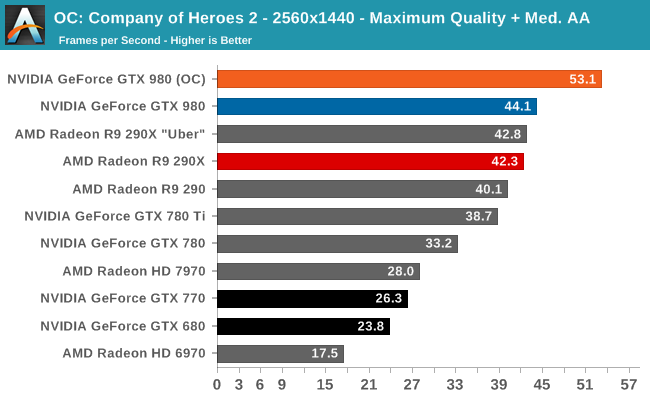
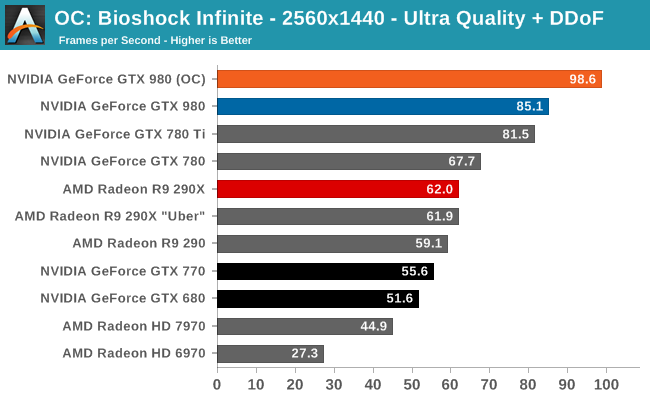
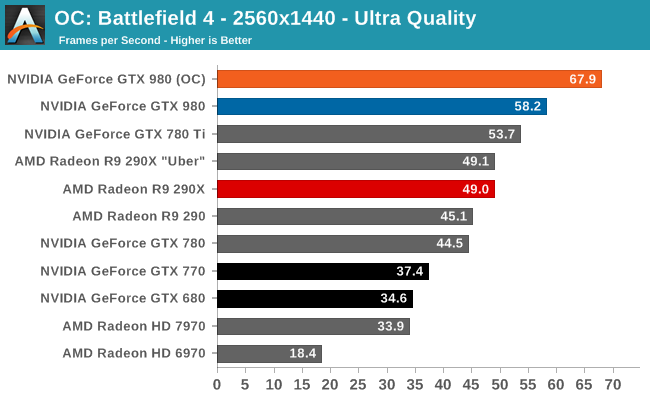
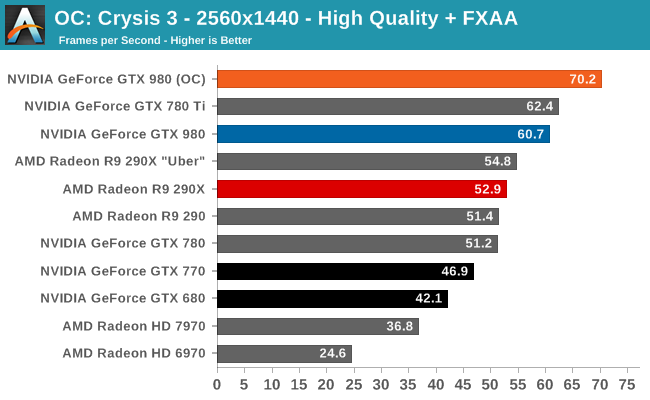
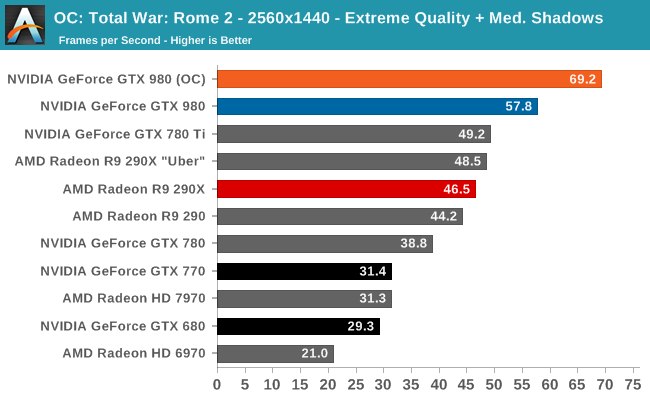
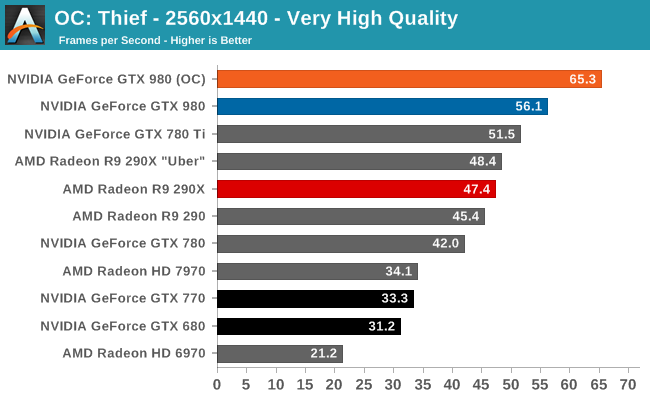
To put it simply, the GTX 980 was already topping the charts. Now with overclocking it’s another 15-20% faster yet. With this overclock factored in the GTX 980 is routinely 2x faster than the GTX 680, if not slightly more.
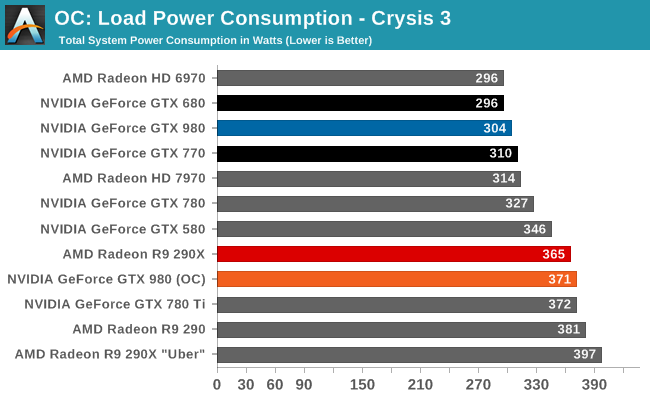
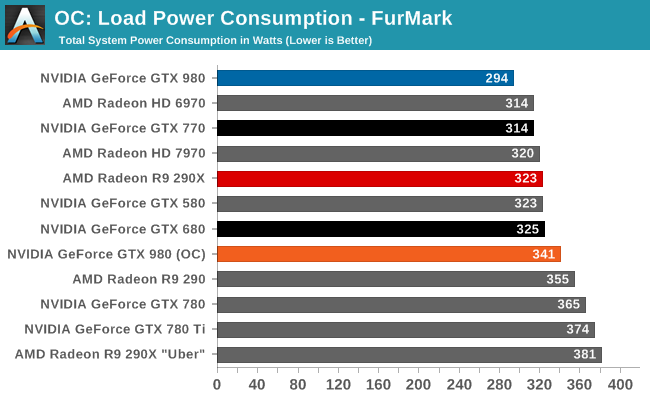
But you do pay for the overclock when it comes to power consumption. NVIDIA allows you to increase the TDP by 25%, and to hit these performance numbers you are going to need every bit of that. So what was once a 165W card is now a 205W card.


Even though overclocking involves raising the temperature limit to 91C, NVIDIA's fan curve naturally tops out at 84C. So even in the case of overclocking the GTX 980 isn't going to reach temperatures higher than the mid-80s.
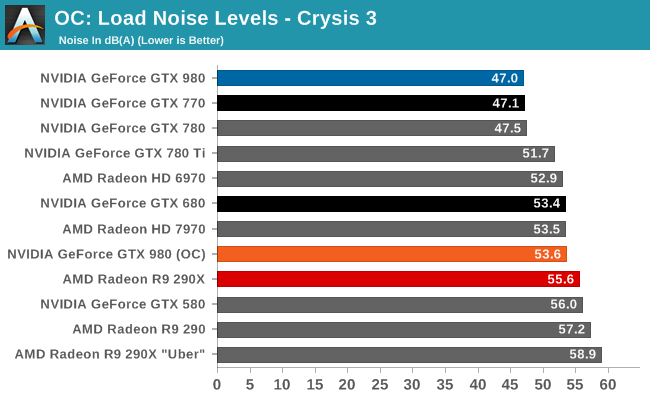

The noise penalty for overclocking is also pretty stiff. Since we're otherwise TDP limited, all of our workloads top out at 53.6dB, some 6.6dB higher than stock. In the big picture this means the overclocked GTX 980 is still in the middl of the pack, but it is noticably louder than before and louder than a few of NVIDIA's other cards. However interestingly enough it's no worse than the original stock GTX 680 at Crysis 3, and still better than said GTX 680 under FurMark. It's also still quieter than the stock Radeon R9 290X, not to mention the louder yet uber mode.










274 Comments
View All Comments
hojnikb - Friday, September 19, 2014 - link
7950 (which was then rebranded to 280) had 200W. With 280, they obviously upped the TDP for longer turbo speeds.ArtForz - Saturday, September 20, 2014 - link
Wasn't the 280 more of a rebranded 7950 boost (925 turbo), and not a 7950 (825, no turbo at all)?Mr Perfect - Friday, September 19, 2014 - link
True, but the 285 didn't live up to the 180 watt claim. Later in the article they showed it saving only 13 watts under load when compared to the 280. So more like 237 watts?http://www.anandtech.com/show/8460/amd-radeon-r9-2...
Which was really quite disappointing. I need something to cram in my mITX rig, and it has to be close to the 150 watts of the 6870 in there now.
Samus - Friday, September 19, 2014 - link
On a per-watt scale, AMD's GPU's are now as inefficient as their CPU's when compared to the competition. It's good they got those console contracts, because they probably won't be getting the next round if this keeps up.Absolutely amazing Maxwell is twice as efficient per watt as GCN 1.2
Laststop311 - Friday, September 19, 2014 - link
well looks like the gtx 970 is calling your name thenAlexvrb - Saturday, September 20, 2014 - link
That seems to depend on the design reviewed. THG tested a similarly clocked card by a different manufacturer and there was a much larger gap between the 280 and 285 in terms of power consumption.With that being said the 980 and 970 are both extremely fast and power efficient. Especially the 970 - if it really hits the market at around that pricing wow! Incredible value.
Strange that the 980 throttles so much at stock settings even outside of Furmark, first thing I'd do is go into the settings and fiddle a bit until it boosts consistently. But given its performance and it's not really a problem, and it can be remedied. Still, something to keep in mind especially when overclocking. I wonder how the 980 would have done with the beefier cooler from its higher-TDP predecessors, and some mild overvolting?
Laststop311 - Sunday, September 21, 2014 - link
If you look in the gaming benchmarks the gpu is hitting 80C. Nvidia's design does not allow the gpu to exceed 80C so it has to lower frequencies to stay at 80C. This is the consequence of using the titan blower cooler but removing the vapor chamber lowering its cooling capability. That's why I don't get why all these people are rushing to buy the reference design gtx 980's as they are all sold out. They are throttling by hundreds of mhz because the titan blower cooler without a vapor chamber sucks. Custom cooling options are going to make the gtx 980 able to reliably hit 1300-1400 mhz some probably even 1500 mhz under full load and still stay under the 80C limit. Keep an eye out for MSI's twin frozr V design. It's going to have a beefy radiator with 2x 100mm fans in an open air design allowing WAY more cooling potential then the reference design. The twin frozr V design should allow the card to OC and actually keep those OC frequencies under heavy load unlike the reference card which cant even keep up with its stock setting under intense gaming. We should see a pretty big performance jump going to custom coolers and the reference performance is already staggeringAlexvrb - Sunday, September 21, 2014 - link
Reviewers and "tech enthusiasts" alike jumped all over AMD when they didn't adequately cool their 290 cards. So while I don't disagree with what you're saying, I am just surprised that they would let it ship with such heavy throttling on ordinary games. Especially given that in this case it isn't because Nvidia shipped with a cooler that isn't sufficient - rather it's because by default the fan is running too slowly. Even without the vapor chamber, I bet it would be fine if they just turned up the fan just a hair. Not enough to make it loud, but enough to bring it in line with some of the other high-end cards here (under a load).Anyway I suspect the vapor chamber will return in a higher-end "980 Ti" type configuration. In the meantime, yeah I'd keep an eye out for high-end aftermarket designs with a more aggressive power delivery system and wicked cooling. There's no doubt these chips have serious potential! I'd bet an aggressive 970 could hit the market for under $400 with 980-like performance and a factory warranty. :D
I'd say "poor AMD" but this kind of leapfrogging is nothing new. Even if AMD can't come out with something really impressive in the next several months, they can always remain competitive by dropping prices. My GPU is idle outside of gaming so the actual difference in power consumption in terms of dollars is tiny. Now, for number-crunching rigs that run their GPUs 24/7... that's a different story altogether. But then again, AMD's professional cards have good DP numbers so it's kind of a wash.
Hixbot - Monday, September 22, 2014 - link
I'm very disappointed they got rid of the vapor chamber. I'm not a fan of the 3rd party coolers as they exhaust the air into the case (big deal for small form factor PCs). I prefer the blower cooler even though they are noisier, the loss of the vapor chamber is a big deal.Viewgamer - Friday, September 19, 2014 - link
LOL people screaming at the 285. It actually consumes less power than the 980 and 970 not more.Nvidia greatly understated the TDP of the 980 and 970 to put it lightly.
Both cards consume more power than the 250W TDP 7970 Ghz yet they're somehow rated at 165W and 145W how laughable !
http://i.imgur.com/nfueVP7.png